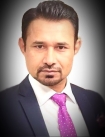Politics
Iran, thirstier than ever, nears total dryness under failed leadership
Is Iran facing water, economy crisis?

Thirst and Fear: A Nation in Shadows (Source: Saman Hajibabaei )
USPA NEWS -
Iran — a land stretching 1,648,195 square kilometers — is no longer just dry soil; it is a nation gasping for survival. Where once there were rivers, lakes, and vibrant life, now lie cracked earth and the silence of extinction.
Who is to blame?
The climate?
The heavens?
Or the man who has ruled from a throne of silence and suppression for over three decades — watching as the country’s lifeblood vanished beneath his feet?
Ali Khamenei.
The Supreme Leader under whose watch Iran’s greatest natural treasures have perished: Lake Urmia, 90% gone. Lake Bakhtegan, a memory. Hamun and Gavkhouni — sacrificed. This wasn’t fate. It was failure — calculated, systemic, and unforgivable.
Years of dam-building madness. Groundwater sucked dry.
Pseudoscience driving policy.
And as the soil died, so did truth — as scientists were silenced and farmers forgotten.
Iran should have been a beacon of sustainability. Instead, it became a cautionary tale of arrogance, denial, and decay.
Now, Iran is a nation without water. Without light. Without future.
And still, at the helm, stands the same man — unaccountable, unmoved, and dangerously powerful.
Who is to blame?
The climate?
The heavens?
Or the man who has ruled from a throne of silence and suppression for over three decades — watching as the country’s lifeblood vanished beneath his feet?
Ali Khamenei.
The Supreme Leader under whose watch Iran’s greatest natural treasures have perished: Lake Urmia, 90% gone. Lake Bakhtegan, a memory. Hamun and Gavkhouni — sacrificed. This wasn’t fate. It was failure — calculated, systemic, and unforgivable.
Years of dam-building madness. Groundwater sucked dry.
Pseudoscience driving policy.
And as the soil died, so did truth — as scientists were silenced and farmers forgotten.
Iran should have been a beacon of sustainability. Instead, it became a cautionary tale of arrogance, denial, and decay.
Now, Iran is a nation without water. Without light. Without future.
And still, at the helm, stands the same man — unaccountable, unmoved, and dangerously powerful.
A Nation Trapped in Endless Crises, a Regime That Only Lies While People Suffer
Iran today is a country ensnared in a web of overlapping crises. The regime not only refuses to take responsibility but also spreads lies and creates terrorist groups.During just 12 days of escalating conflict, we witnessed Israeli warplanes refueling in Tehran’s skies—clear evidence of the regime’s deep weakness.
This government cares about nothing.
It only lies.
It only steals.
And innocent people pay the price for all this failure.
Iranians no longer face just economic hardship—they have no electricity, no water, no internet. They have lost even the most basic right to live.
These crises aren’t accidents or bad luck. They are the result of corrupt, ruthless mismanagement by a regime gambling with the future of millions.
Iran’s Crises: A Closer Look
1.Economic Collapse: The Iranian economy is in freefall.Hyperinflation, skyrocketing unemployment, and a collapsing currency have left millions in poverty.
Basic goods are scarce, and the middle class is rapidly disappearing.
2.Infrastructure Failure: Power outages, water shortages, and internet blackouts have become routine. The regime’s inability to maintain essential services has crippled daily life.
3.Political Repression: Dissent is met with brutal force. Thousands have been arrested, and many more live in fear of arbitrary detention. The regime’s crackdown on freedom of expression has silenced any opposition.
4.Foreign Policy Misadventures: Iran’s involvement in regional conflicts has isolated it internationally. The regime’s support for militant groups has led to sanctions and diplomatic isolation.
5.Environmental Degradation: Mismanagement of natural resources has led to environmental disasters. Air and water pollution are at alarming levels, and the country faces severe droughts.
The Iranian people are bearing the brunt of these crises. Protests erupt regularly, but they are met with violent repression.
Iran in Crisis: From Brutal Repression to International Inaction
Human rights experts believe that the silence or inaction of the international community in the face of Iran’s bloody crackdowns has contributed to the repetition of these atrocities. A review of some of the most significant crackdowns in Iran’s recent history illustrates this pattern:•1988 – Mass execution of political prisoners: According to Amnesty International, thousands of political prisoners were executed without fair trials in Iranian prisons.
These executions remain uninvestigated and unpunished to this day.
Source: Wikipedia – 1988 executions of Iranian political prisoners
•2009 – Green Movement: Following the disputed presidential election, protesters took to the streets.
The government responded by arresting thousands and killing dozens of demonstrators.
Source: Wikipedia – Iranian Green Movement
•November 2019 – Bloody Aban Protests: In just four days, Iranian security forces killed over 1,500 protesters with live ammunition on the streets. The massacre coincided with a nationwide internet blackout.
Source: Wikipedia – 2019–2020 Iranian protests
•September 2022 – Woman, Life, Freedom Movement: The death of 22-year-old Mahsa Amini in the custody of Iran’s morality police sparked nationwide protests. Hundreds were killed, including children such as 9-year-old Kian Pirfalak, who was shot dead by security forces.
Source: Wikipedia – Mahsa Amini protests
Structural Crises in Iran
Iran today is not only facing a human rights crisis; the country is experiencing collapse across nearly every aspect of social life:• Economic Collapse: Uncontrolled inflation, widespread unemployment, and the sharp devaluation of the rial have pushed millions below the poverty line.
• Infrastructure Breakdown: Frequent power outages, shortages of clean drinking water, and widespread internet blackouts have become a permanent feature of daily life.
• Environmental Collapse: Drought, severe air and water pollution, and mismanagement of natural resources are threatening the ecological future of the country.
• Diplomatic Isolation: The regime’s support for militant groups across the region has resulted in crippling sanctions and deep international isolation.
Global Response to Iran: Endless Concern, No Action, No Accountability
UNICEF.The United Nations.
Human rights organizations.
Me.
You.
Us.
We are concerned—for Ukraine.
We are concerned—for Iran.
We are concerned—for the children of the world.
We are concerned—for Afghanistan.
We are concerned—for Libya.
We are concerned—for Ethiopia.
We are just… concerned.
We are always concerned.
And still, we remain concerned.
But what has this concern changed?
Where are the consequences for regimes that shoot children in the streets?
Where is the accountability for governments that kill their own citizens en masse, then cut the internet to silence the world?
The international community’s response to Iran’s suffering—like so many other places—has become a rehearsed ritual of hollow statements. “Deep concern” has become a euphemism for doing nothing. We no longer need sympathy; we need action, courage, and consequence.
Empty words don’t stop bullets. Concern doesn’t bring back the dead.
I speak for the world our children will inherit. Just an ordinary human.
World, can you hear us?We are the people.
Wasn’t it always said that governments are formed to serve the people?
Aren’t presidents, prime ministers, ministers, parliamentarians, and every single official working in the United Nations paid to protect our lives—your life, my life, our children’s lives?
Isn’t that their job?
Isn’t that their duty?
Then why are they only “concerned”?
Why do they live in luxury—in the finest hotels, with the finest privileges—
while we bury our children, protest in the streets, and live without water, power, or safety?
Where is justice when “concern” is all they can offer?
Where is humanity when duty is replaced by silence?
Tables and chairs, bank account balances, and escaping responsibility have taken the place they shouldn’t.
Those who are supposed to serve me and us—the eight billion humans who own this planet—should be fulfilling their duty.
All these tables, all this “protection,” and complete freedom should belong to the people, not to them.
They are making a grave mistake.
Some people have illusions—they believe that secret shadowy forces control everything behind the scenes. But no, that’s not true.
The nightmare we see on the news? That’s exactly what’s happening—no more, no less.
Some even think the fate of the world lies in the hands of aliens. Yet we haven’t fully explored our own oceans, let alone space!
Many believe politicians know more than you and me. They don’t. We are no different from them.
If anything, they depend on life more desperately than we do.
The biggest difference between us and them? We know we are not eternal.
We are travelers on a journey—we won’t be here in a hundred years.
But they take themselves far too seriously.
They have abandoned us to a thirsty world, scattered across the earth.
They are turning this green planet—a right owed to our children—into a desert.
So tell me, is the cost of changing incompetent regimes like the Islamic Republic, the Taliban, and others really higher than the price of dried rivers and vanished lakes decades from now?
Is it right that our children will only dream of clean water?
Why isn’t Iran part of the global environmental agreements?
Why?
The nightmare we see on the news? That’s exactly what’s happening—no more, no less.
Some even think the fate of the world lies in the hands of aliens. Yet we haven’t fully explored our own oceans, let alone space!
Many believe politicians know more than you and me. They don’t. We are no different from them.
If anything, they depend on life more desperately than we do.
The biggest difference between us and them? We know we are not eternal.
We are travelers on a journey—we won’t be here in a hundred years.
But they take themselves far too seriously.
They have abandoned us to a thirsty world, scattered across the earth.
They are turning this green planet—a right owed to our children—into a desert.
So tell me, is the cost of changing incompetent regimes like the Islamic Republic, the Taliban, and others really higher than the price of dried rivers and vanished lakes decades from now?
Is it right that our children will only dream of clean water?
Why isn’t Iran part of the global environmental agreements?
Why?
We stay silent and watch.
They speak—but they do not see.
I wish there were no borders. I wish we all truly understood that we, as human beings, are equal—no matter where we come from.
I wish we valued this earth more and stopped fighting each other over lines drawn in the sand.
My name is Saman Hajibabaei.
To every one of you who has read this far, I offer a sincere request:
Please think of Iran—not just as a name or a country on a map, but as a part of this shared planet.
A nation that, if free, could benefit not only its own people but all of humanity.
Let us look beyond borders and national flags.
Iran, like Afghanistan, Ukraine, Libya, Yemen, and so many others, belongs to the earth itself—not to any one ruler, regime, or ideology.
Let’s look at these nations not as “others” but as “our own”—as fellow humans, as fellow earth-dwellers.
I am not a journalist.
I write simply so that future generations may know what happened to us.
Let this remain. Let them read. Let them avoid our mistakes.
You are completely free to share, copy, and use this text however you wish.
Thank you—truly—for your time, your kindness, and your patience.
They speak—but they do not see.
I wish there were no borders. I wish we all truly understood that we, as human beings, are equal—no matter where we come from.
I wish we valued this earth more and stopped fighting each other over lines drawn in the sand.
My name is Saman Hajibabaei.
To every one of you who has read this far, I offer a sincere request:
Please think of Iran—not just as a name or a country on a map, but as a part of this shared planet.
A nation that, if free, could benefit not only its own people but all of humanity.
Let us look beyond borders and national flags.
Iran, like Afghanistan, Ukraine, Libya, Yemen, and so many others, belongs to the earth itself—not to any one ruler, regime, or ideology.
Let’s look at these nations not as “others” but as “our own”—as fellow humans, as fellow earth-dwellers.
I am not a journalist.
I write simply so that future generations may know what happened to us.
Let this remain. Let them read. Let them avoid our mistakes.
You are completely free to share, copy, and use this text however you wish.
Thank you—truly—for your time, your kindness, and your patience.
more information: https://https://www.bobshub.de/
Liability for this article lies with the author, who also holds the copyright. Editorial content from USPA may be quoted on other websites as long as the quote comprises no more than 5% of the entire text, is marked as such and the source is named (via hyperlink).






